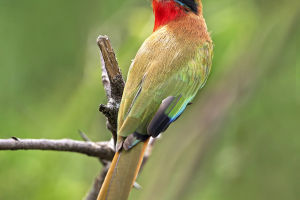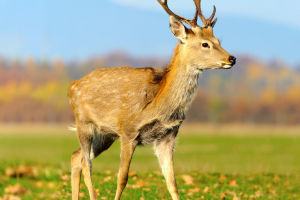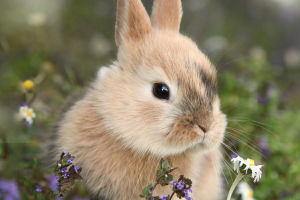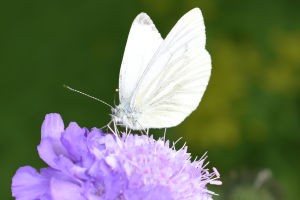
Sheep Habits

The sheep is a mammal of the order Artiodactyla, family Bovidae.
It has a plump body and dense wool; rams often have spirally twisted large horns, while ewes are either hornless or have small horns; the skull has tear pits, and the nasal bones are prominent;
Sheep possess interdigital glands on all four hooves and have pointed mouths with thin, flexible lips. Their weight can range from tens to over a hundred kilograms, and they typically live up to about 15 years.
Habits
① Gentle temperament: Sheep are gentle and timid, moving slowly. Utilizing this characteristic, sheep can be trained to obey commands, facilitating grazing management. When suddenly frightened, they perk up their ears, widen their eyes, and run around, causing a "stampede".
Related
 You never thought birds had language before!
You never thought birds had language before!
 The Holland Lop family has always been a popular breed of pet rabbit.
The Holland Lop family has always been a popular breed of pet rabbit.
 Deer, renowned for elegance and adaptability, embodies the marvels of nature across diverse habitats, urging stewardship.
Deer, renowned for elegance and adaptability, embodies the marvels of nature across diverse habitats, urging stewardship.
 Butterflies rely on intricate senses to navigate, taste, and communicate in nature.
Butterflies rely on intricate senses to navigate, taste, and communicate in nature.
 Rabbit tails, though short, serve as warnings and aid navigation in nature.
Rabbit tails, though short, serve as warnings and aid navigation in nature.
 Butterflies are symbols of beauty and culture, enrich ecosystems, and inspire creativity.
Butterflies are symbols of beauty and culture, enrich ecosystems, and inspire creativity.
When grazing, attention should be paid to maintaining a quiet environment. Despite having large horns, rams cannot defend themselves due to their timidity and are vulnerable to attacks from wild animals such as wolves. Sheep have a strong flocking instinct, preferring to gather together, which is conducive to group grazing.
When a flock enters or exits a pen, crosses a bridge, a river, or passes through a narrow passage, as long as the "lead sheep" goes first, the rest of the sheep will follow, making it easy to drive and manage the flock. In terms of breeds, coarse-wooled sheep have the strongest flocking instinct, followed by fine-wooled sheep, with semi-fine-wooled sheep being the least.
Of course, the flocking instinct of sheep varies with the seasons. For example, in summer when grass is abundant, flocking instinct is strong, while in winter and spring, flocking instinct tends to be weaker due to competition for dry grass, leaves, etc.
② Prefers dryness and cleanliness: Sheep prefer dryness and are averse to dampness and heat. In humid and hot environments or when grazing in low-lying grasslands, they are prone to diseases such as parasitic infections and arthritis. Sheep are covered in dense wool and have thick skin, so they generally tolerate cold but are sensitive to heat.
During hot summers, overcrowding of sheep should be avoided to prevent them from huddling together, especially fine-wooled sheep, which require extra care to prevent heatstroke. They should be rested in the shade of trees during hot days and grazed only when the sun is less intense. Shelter should also be provided in harsh winter conditions to maintain dryness and protect them from wind and snow.
③ Sharp sense of smell: Sheep have a well-developed sense of smell. Before eating grass, they always sniff it first. They dislike feeding on grass contaminated with soil or having an unusual odor. Therefore, when grazing, it's important to regularly rotate pastures; feed should be placed in racks or troughs rather than directly on the ground; clean the feeding area before each feeding to ensure that the sheep eat enough and consume feed efficiently.
Sheep prefer drinking clean flowing water or spring water and avoid drinking water that is contaminated or unclean. When grazing, it's important to ensure access to clean water to prevent them from drinking dirty or contaminated water.
Sheep have thin and flexible lips and sharp incisors, enabling them to graze on low-lying grass and roots. They consume a variety of plant species, accounting for about 88% of the total feed plant species, preferring grasses from the Gramineae and Leguminosae families, they also consume fallen leaves and weeds.
④ Strong adaptability: Sheep has strong adaptability to environmental conditions, exhibiting greater tolerance and resilience under adverse conditions compared to other livestock. This adaptability varies depending on the sheep breed.

Fine-wooled sheep generally tolerate dryness and cold but are not adapted to heat; while semi-fine-wooled sheep breeds can withstand humid and hot conditions but are not resistant to drought, preferring environments with lush green feed. Therefore, when managing and raising sheep, it's important to consider the characteristics of their breeds to raise them effectively.
As gentle and flock-oriented animals, sheep have become important livestock resources worldwide under human domestication and management. Through scientific husbandry practices, the production potential of sheep can be maximized, providing high-quality meat, wool, and other products to humans, while also contributing to the conservation and reproduction of this species.